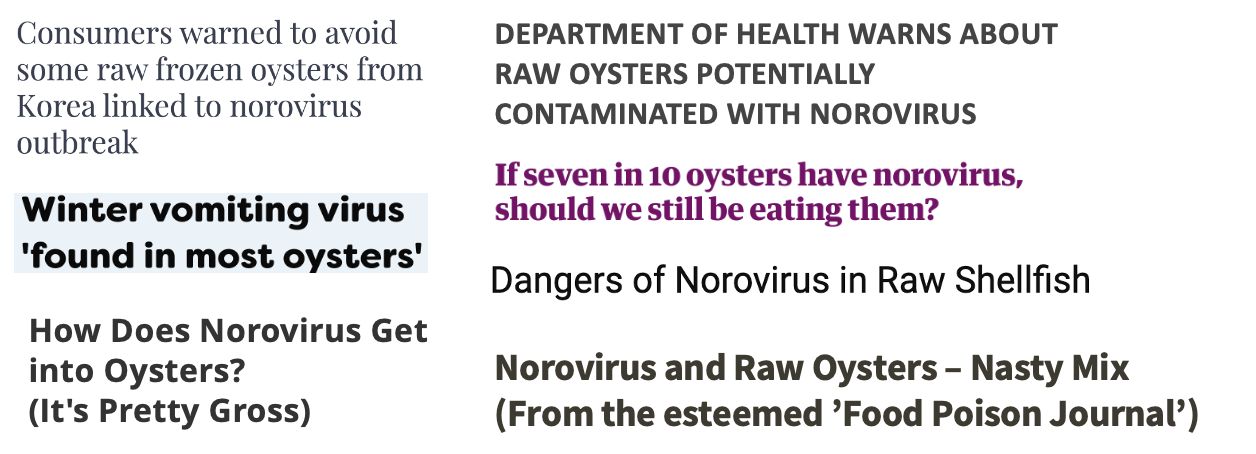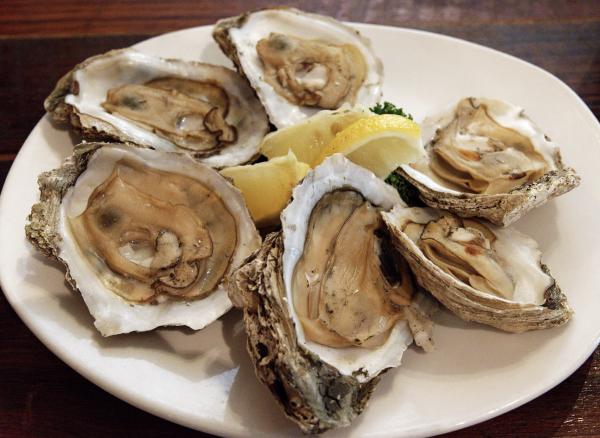No accounting for taste. When at a seafood restaurant with friends, it's common to see others order and gulp down a half-dozen loogies raw oysters. Having never been known as the most adventurous eater (wife: "he's a fussy pain in the ass"), it is understandable why I'd rather starve than eat turkey gonads, sheep eyeballs, or raw oysters. But, at least for the last one, there is some science to back up my "fussy-pain-in-the-ass" designation. Raw oysters are a splendid environment for germs to thrive because they are filter feeders – creatures that dwell near the bottom of the food chain. They bury themselves and suck in salt water, extracting whatever vile things happen to be nearby and spitting out cleaner water. Nice life.
According to the Ocean Conservancy:
Filter feeders can help keep things balanced. For example, mussels and oysters are filter feeders that remove plankton, bacteria, and toxins from the water and even increase ecosystem health.
What they don't say is 1) they also remove viruses, 2) what they remove you slurp up, and 3) you can get mighty sick. How so? Here are a bunch of headlines that took me about 30 seconds to find:


But it Gets Better: Raw Oysters in the News
So, perhaps you're OK with taking your chances with norovirus, one of the most contagious viruses of all (1). Maybe the simultaneous spewing of vile liquids from two different orifices doesn't bother you (it's no worse than watching the new Sex and the City). But oysters can pick up something far worse than norovirus, especially in warm water. Although the number of cases is very low, people have died from eating raw oysters contaminated with Vibrio vulnificus, the "flesh-eating bacteria," or simply from exposure to it while swimming.
This is not the pathogen you want to toy with. A CNN report (today) says:
A mild case of the bacterial infection vibriosis can cause skin wounds, blisters, abscesses and ulcers. It typically includes chills, fever, diarrhea, stomach pain and possibly vomiting. [emphasis mine]
Keep in mind that at this time, there have been only three fatalities in the Northeast, only one of which has been attributed to oysters. But these numbers are likely to increase; the initial reports are new, and the sea surface temperature in the Northeast is now at its peak.

Source: SeaTemperature.org
Vibrio vulnificus bacteria, which occurs naturally in saltwater coastal environments and can be found in higher concentrations from May to October when the weather is warmer.
Dr. James McDonald, New York state health commissioner
Whether from the planet warming, El Nino, some combination of both, or other factors, it is indisputable that ocean temperatures this summer have been the warmest ever (and not by a little). Since Vibrio thrives in warm water, seeing more cases occurring further north would not be surprising.
Don't Mess With Vibrio: Necrotizing fasciitis (NF)
There is no need to invent a fictitious nasty pathogen for a Netflix series, should yet another one (inevitably?) appear. Vibrio is truly a horrific bacteria. Its mortality rate is about 20%, and even those who survive often do not do so unscathed. Although it can be transmitted (thankfully rarely) from water when the bacteria find an open wound, this can (again, very rarely) cause necrotizing fasciitis, a very dangerous condition. There are about 1,500 cases of NF annually in the US. You don't want to be one of them. According to the Cleveland Clinic, the most serious symptoms include:
- Reddened and/or discolored skin
- Swelling of affected tissues
- Unstable blood flow
- Blisters filled with bloody or yellowish fluid
- Tissue death (necrosis) (often leading to amputation)
- Low blood pressure
- Sepsis
- Death
Bottom Line
The chances of any person becoming infected by Vibrio vulnificus are very low. But, given the abnormally warm sea temperatures, it would not be unexpected to see more cases than usual. Should you eat raw oysters? That's up to you. I'll stick to Twinkies. Safer and tastier.

NOTE:
(1) A few as 10-100 norovirus particles are sufficient to make you sick. That is a very low number in the world of pathogens.




